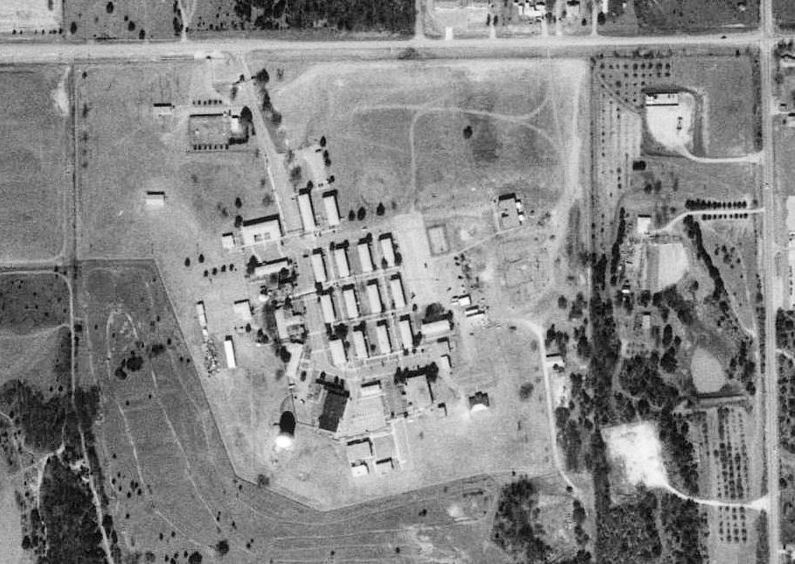Oklahoma City Air Force Station
|
Oklahoma City Air Force Station (1951-1983) - A Cold War Air Force Station first established in 1951 near Tinker AFB, Oklahoma County, Oklahoma. Named Oklahoma City Air Force Station after the location. Several air defense facilities were built at the Air Force Station including radar site P-52 and a Manual Air-Defense Control Center P-86. The radar site was initially assigned a Permanent ID of P-52 and later a Sage ID of Z-52. The Manual Air-Defense Control Center was initially assigned a Permanent ID of P-86 and later MCC-11. A series of air defense sector headquarters occupied the air force station along with the Manual Air-Defense Control Center. The Air Force Station was merged into nearby Tinker Air Force Base in 1983 and the radar site became Oklahoma City FAA Radar Site with an FAA ID of OKC.
HistoryEstablished on 1 May 1951 at Oklahoma City Air Force Station manned by the 746th AC&W Squadron. The station initially had both a Ground-Control Intercept (GCI) and early warning radar mission. The early warning mission involved tracking and identifying all aircraft entering their airspace while the GCI mission involved guiding Air Force interceptors to any identified enemy aircraft. Controllers at the station vectored fighter aircraft at the correct course and speed to intercept enemy aircraft using voice commands via ground-to-air radio. Initial equipment included two FPS-10 search radars and added an FPS-6 height-finder radar in 1958. Oklahoma City Manual Direction Center P-86The 33rd Air Division Headquarters moved to Oklahoma City AFS on 8 May 1956 and activated a Manual Air-Defense Control Center (ADCC), P-86. The ADCC controlled Air Defense Command (ADC) interceptor aircraft in Oklahoma, Kansas, and Texas. The Oklahoma City Air Defense Sector (OCADS) was established on 1 Jan 1960 as a manual ADS, without a SAGE blockhouse. OCADS continued the Manual Air-Defense Control Center role and added additional AC&W radar sites as did the successor headquarters, all at Oklahoma City AFS. This operation of the P-52 radar site and the manual control center (P-86 and MCC-11) continued until discontinued in 1968.
Oklahoma City FAA Radar Site With the deactivation of the 746th in 1968, the FAA assumed operation of the radar site within a small compound. The initial FAA FPS-67B search radar remained in operation until it was modified to become a CARSR radar with a 1561 Antenna. The FAA ID for this site is OKC. A FYQ-47 Common Digitizer was probably placed in service by February 1973 when the USAF/FAA FST-2 to FYQ-47 replacement program was completed. By 1990 the site was equipped with a Common Digitizer CD-2A and an FPS-67B search radar. The Oklahoma City CD-2A was scheduled to receive an upgrade kit to implement three level weather data processing on 27 Jul 1990.
CARSR RadarThe nationwide replacement program converting FAA legacy radar systems to the CARSR radar configuration was completed by 17 Aug 2015 and Oklahoma City FAA Radar Site was a part of that program. Legacy FAA radars underwent a Service Life Extension Program (SLEP) that replaced key components in the vintage ARSR-1, ARSR-2, FPS-20, FPS-66 and FPS-67 radars. The CARSR program replaced legacy klystron radar transmitters with a solid-state transmitter as well as renovating the radar receiver and signal processor. The CARSR modification also included common digitizer functionality making a separate common digitizer unnecessary. The Oklahoma City FAA Radar Site is now operating with the CARSR radar. At the time of the CARSR changeout, the legacy radar in place was an FPS-67B and the CARSR conversion included a 1561 Antenna. The secondary radar for this site is the ATCBI-6 Beacon set. The radar site data is now available to the USAF/NORAD Battle Control System-Fixed (BCS-F) operations centers (EADS & WADS) as well as the FAA Fort Worth ARTCC (ZFW) and adjacent ARTCCs. Other federal agencies have access to the data under the Homeland Security umbrella. Physical PlantThe physical plant of the Air Force station was divided into the main site and a cantonment area. The main site housed the operations buildings, the radar towers, and the backup generators. The cantonment area housed the enlisted barracks, the bachelor officer's quarters, the orderly room, the dining hall, the motor pool, and other support buildings.
Current StatusActive military installation now part of Tinker AFB, Oklahoma County, Oklahoma. The FAA still operates a Common Air-Route Surveillance Radar (CARSR) radar at this location data tied to the JSS system. Other tenant organizations occupy parts of the site. Most, if not all, the cantonment buildings appear to have been removed.
See Also:
Sources:
Links: Visited: 7 Sep 2019
| |||||||||||||||||||||||||||||||||||||||||||||||||||||||||||||||||||||||||||||||||||||||||||||||||||||||||||||||||||||||||||||||||||||||||||||||||||||||||||||||||||||||||||||||||||||||||||||||||||||||||||||||||||||||||||||||||||||||||||||||||||||||||||||||||||||||||||||||||
